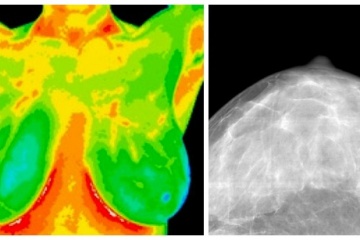
It seems like “thermography vs. mammogram” is all the buzz amongst women age 30 and up, and for good reason – cancer is now the #1 fatal disease, and one in eight women will develop invasive breast cancer.
The medical community strongly recommends mammograms as an “early detection” tool, but in alternative circles it is believed that mammograms can actually contribute to breast cancer and may only be questionably effective in helping to save lives.
Do mammograms increase the risk of breast cancer?
I'm going to step into my science-nerd costume for just a minute here, so bear with me:
Radiation is measured in millisieverts (mSv). We are naturally exposed to radiation through our environment (called “natural background radiation”), and according to Wikipedia, “The worldwide average natural dose to humans is about 2.4 mSv per year” with the U.S. coming in around 3.1 mSv.
RadiologyInfo.org breaks down the amount of radiation in particular xrays:
- A standard chest xray is 0.1 mSv = 10 days of natural background radiation.
- A mammogram is 0.7 mSv = 7 weeks of natural background radiation.
- A spinal xray is 1.5 mSv = 6 months of natural background radiation.
- An abdominal and pelvic xray is 10-20 mSv = 3-7 years of natural background radiation.
As you can see, a single mammogram is not really an astounding amount of radiation, however, since the National Cancer Institute now recommends that women over 40 receive a mammogram every 1-2 years, over the course of a few decades this exposure certainly adds up.
But how much risk is associated with regular mammograms? Well, one mammogram carries the same amount of risk as smoking 3 packs of cigarettes. For some this may seem like an acceptable calculated risk each year over the alternative of undetected breast cancer.
As much as I'd prefer to side with my crunchy friends on this one, it's not completely clear that radiation from mammograms will increase the risk of breast cancer enough to justify avoiding the test – especially when used in conjunction with breast thermography as outlined below.
There is also debate whether or not the extreme compression of breast tissue during a mammogram may lead to the spread of malignant cells due to rupture of associated blood vessels. I don't know about you, but I'd like an option that would prevent me from having enough malignant cells in my breast worth spreading, wouldn't you?
So the next question to tackle…
Do mammograms really provide sufficient early detection of breast cancer?
A mammogram is a high powered x-ray that looks for anatomical changes in breast tissue such as lumps or masses. Thermography is infrared photography detects physiological differences – namely increased heat and blood flow – relative to surrounding tissue.
According to Sandra Fields, a nurse midwife and thermography proponent who writes for the renowned herbalist, Susun Weed:
By the time a tumor reaches the size of a pin head (approximately two years into its growth) it can no longer be sustained by the normal blood supply and so it develops its own. The development of that blood supply is called angiogenesis. Thermography is the only technology in place that can detect angiogenesis.
Mammogram is not early detection. A cancerous tumor has been growing eight to ten years before it is big enough and dense enough to be detected by mammography. That is why the treatment at that stage is so drastic – removal of breast, underlying muscle, lymph nodes, chemotherapy, radiation therapy and hormonal therapy. (my emphases in bold)
Following early detection with thermography, the appropriate treatment is usually diet and lifestyle modifications as opposed to the invasive treatment at later detection.
In June of 2011, the FDA released a press announcement stating that breast thermography is not a substitute for mammography.
The International Academy of Clinical Thermology (IACT) agrees with the FDA, explaining that thermography is actually a different type of diagnostic tool altogether, providing earlier detection of abnormal cell activity for more proactive preventative care. When added to a woman's regular breast health checkups (manual exams and mammograms), there is a 61% increased survival rate. (source)
Fields sums it up well:
Mammogram should be placed in it's proper hierarchy.
[After manual exams,] first thermography, if suspicious, then sonography [ultrasound], if suspicious, then mammogram to pinpoint the exact location of an existing tumor for biopsy.
7 additional facts about thermography vs. mammograms
- Breast thermography has been FDA approved as an adjunct diagnostic tool to mammograms since 1982.
- There have been 800 peer-reviewed breast thermography studies in which over a quarter million women have participated in large-scale studies over 12 years. These studies show thermography to be 90% accurate.
- Mammograms in pre-menopausal women can be up to 89% inaccurate, leading to unnecessary procedures, as well as emotional and physical trauma.
- Many false negatives occur with mammograms since tumors are frequently located in the upper outer aspects of the breasts where the scans do not reach.
- In Europe, Canada, & Australia healthy breasts are routinely screened with thermography and mammograms are used as a second line of diagnosis.
- For earliest detection and prevention, it is recommended that women receive baseline breast thermography at age 20, every three years between ages 20-30, and annually from age 30.
- Starting breast thermography at any age gives you the safest and earliest detection possible.
What do you think?
Thermography? Mammograms? Or both?
Sources:
fda.gov/NewsEvents/Newsroom/PressAnnouncements/ucm257633.htm
naturalhealthcenter.mercola.com/services/Thermography.aspx
knowcancer.com/cancer-tests-diagnosis/thermography/
iact-org.org/patients/breastthermography/what-is-breast-therm.html
susunweed.com/herbal_ezine/February07/grandmother.htm
physics.isu.edu/radinf/risk.htm
radiologyinfo.org/en/pdf/sfty_xray.pdf
newdimensionthermography.com/












I am now 35 years old and with an extensive history of breast and ovarian cancer in my Mum’s side of the family should be starting to get breast checks…but I am opposed to the discomfort of the mammogram and have seen my Mum undergo unneccesary painful biopsies – to the point that 12 years after having breast cancer she refuses to go in for any more mammograms as she always gets selected to go in for extra “tissue samples”…SO I am hoping to convince my doctor to let me go through thermography…I hope it becomes a far more prevalent tool.
Cancer Research: NFCR Cites MHTX’s Early Cancer Detection Tech as Research Breakthrough for 2012… The next quote was from 8 months ago… “Senior Scientific subsidiary, described the company’s recent progress: “We are excited about our completed design for a new sensor system. The new system will give us the ability to detect down to a few hundred cells, 100 times more sensitive in detecting cancer cells than the present instrument which is already 1000 times more sensitive than a mammogram”. They now can detect 10 times better than 8 months back, (down to 1200 cancer cells detectable), and are presently working on down to less than 80 detectable. A mammogram detects down to 1.5 to 2 million cells. This machine uses absolutely no radiation and is 100% safe in the clinical trials going on now. It is a major part in the just announced MD ANDERSON Cancer Research Center saying that Cancer may be a thing of the past in 5 to 10 years.
If you “doctor” doesn’t do what you ask without a reasonable explanation, run and find an alternative doctor. Personally I would never go to an allopathic (conventional) so called “doctor”.
Amen………Naturopath all the way!
I’m coming up quickly upon the age and do plan to get thermography instead of a mammogram. There is a history of breast cancer in my family so I DO want to get screened, but do not want to be put in a vice.
I have never considered a mammogram. However, I have had a thermography. I was satisfied with the results. However, the issue that arose was finding a qualified person to administer the test and “results” of the test. What surprised me was that my OBGYN, at the time, wasn’t into alternative methods; more providers should be open to improved heath test towards detecting breast cancer. Therefore, I had to seek out another provider to insist that I wanted a thermography and not a mammogram. Furthermore, a test such as a thermography should be “covered” under a woman’s health insurance. I am for creating a health system that involves natural health care in combination with the “option(s) of “sick” care.
Last time I asked a friend who is director of radiography department in a hospital. In France there is NO MORE thermography machine. They disapeared a long time ago.
Is there a way to locate trained thermography providers?
I know mammograms are supposed to be safe for most women, but there ARE some women who need to be careful—and I’m not sure how you’re supposed to find out if you’re one of them or not….
“Some studies have suggested women with the genetic mutations could be more sensitive to radiation because the genes are involved in fixing DNA problems. If those genes are damaged by radiation, they might not be able to repair DNA properly, raising the cancer risk.
In several European countries, doctors already advise women with BRCA mutations to get MRIs instead of mammograms before age 30. In the United States, there is no specific advice from a leading task force of government advisers, but the American Cancer Society recommends yearly mammograms and MRIs from age 30 for women with BRCA gene mutations.
In the BMJ study, European researchers followed nearly 2,000 women over age 18 with one of the gene mutations in Britain, France, and the Netherlands. Participants reported their previous chest X-rays and mammograms, including the age of their first screening and the number of procedures. About 850 women were later diagnosed with breast cancer. Roughly half of them had X-rays, while one-third had at least one mammogram, at an average age of 29.
Researchers found women with a history of chest radiation in their 20s had a 43 percent increased relative risk of breast cancer compared with women who had no chest radiation at that age. Any exposure before age 20 seemed to raise the risk by 62 percent. Radiation after age 30 did not seem to affect breast cancer risk.”
http://articles.philly.com/2012-09-08/news/33678331_1_women-with-brca-mutations-brca2-cancer-risk
Which genetic mutations?
I provide thermograms in doctors offices in Fayetteville, NC and 100 mile radius in doctors offices. Some
clients do both thermograms and mammograms. Some do only thermograms and I’m sure some only do mammograms and of course some do nothing. If you are in or near Fayetteville I would be glad to help you. If you are somewhere else I can help you find someone close to you. PictureofHealthThermograms@gmail.com I tried my first thermogram when my mom was going through chemo and radiation for breast cancer. I had had my mammograms but was even more nervous about it when my mom was diagnosed w bc. My first thermograms showed angiogenisous and it scared me straight-no more sodas, more greens and raw veggies and fruits, no more sugar and better overall diet. All bad stuff disapeared-8 years ago. It takes 8-10 years for the transition from angiogenisis to tumor so I feel very lucky to have been advised by my doctor to add thermograms to my breast health care program. I got trained and opened my business to help others to be able to add prevention as I did. Whether you do mammograms or not I hope you add thermograms for that extra time and confidence you get with this technology. Jill
Picture of Health & Thermography, LLC – is still in operation in Fayetteville, NC!
We will gladly assist you on your health journey – New ownership – by a cancer survivor! So grateful Jill brought Thermography to our area! 910-580-2077 – pHThermo@gmail.com – http://www.pHThermography.com
I work in breast imaging the three accepted standards for breast imaging are mammography sonography and Breast MRI if you absolutely must avoid radiation than your money is better spent on a breast MRI I live in Canada and thermography is not a respected form of breaAccordinging why does it not show the heart which has the most amount of blood in the body and sits behind the breast?
When i turn fourty i will be getting annual screening mammos as i havr seen far too many cancers undiagnosed as pattients are afraid of radiation I am afraid of breast cancer going undetected! Also facilities that use digital mammography will use less radiation.
Acc
Accord
Thank you for providing science rather than the quackery provided by so many of these types of sites.
Please don’t mislead your readers and people who follow here from facebook into thinking that natural background radiation is equivalent to radiating your breasts with a mammogram machine. The truth is that just like backscatter scanners at the airport, the US has invested too much money in technology that quickly became outdated. Rather than moving on with the times, doctors, agencies, boards and cancer non-profits are shoving mammograms down our throats. Ask your doctor how long it takes them to recoup their investment of dinosaur technology in the mammogram room. I wish this article didn’t begin with such a “half dozen of one or six of the other” sort of voice because there are a lot of women who aren’t going to read past the first 4 paragraphs.
Are thermography’s availabbe thru your insurance as mam’s are or are they out of pocket and only available for higher economic incomes?
Hi Sylvia – I’m not sure if any insurance providers cover this, but the cost of mine was not astronomical. Definitely worth it in the long run if it can help to detect early cell changes.
Thanks in support of sharing such a pleasant opinion, article is fastidious, thats why i
have read it fully
Women need to know that neither mammography nor thermography is about true prevention. These tests, as any screening test of early detection, are about diagnosis and, often, followed by treatments. Many women who have a thermogram still end up getting invasive orthodox treatments. And, because the medical theories of breast cancer development and progression are quite non-scientific, many women become unnecessary victims of overdiagnosis (read the e-book “The Mammogram Myth: The Independent Investigation Of Mammography The Medical Profession Doesn’t Want You To Know About” by Rolf Hefti). The commercialized medical culture “teaches” women to focus on and rely on them with their”answers” of diagnosis and treatments to the problem of breast cancer, when in fact women ought to focus their attention and efforts on true prevention of the disease. If they did, breast cancer would become a rare event.
I was not looking forward to my first mammograme, and until now was unaware of the dangers……I did have invasive breest cancer and firmly believe that mammograme saved my life….. 2 years down the line and it would have been a wooden box for me… I’m 52 and in England your first mammograme is 50+ I strongly advise all women DO NOT MISS your check ups, I have big boobs and yes it was uncomfortable for at least 2 mins…. I’m still only months down the line but am still glad about that mammograme
Radiation used in mamography is accumulative , it builds up and NEVER leaves the body.
I have Dercum’s Disease. It is a rare condition that means I have thousands of painful lypomas all over my body including my breasts. You cannot imagine the pain a mamogram gives me. My insurance does not allow MRI mamograms for my condition. Insurance is for the middle of the road. Anyone on the shoulders of the road have to beg for help. The sad thing is that if you are on the shoulder, you are too sick to beg.